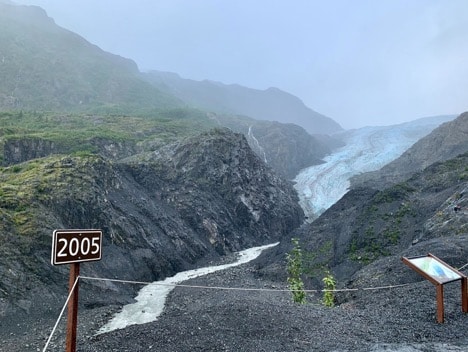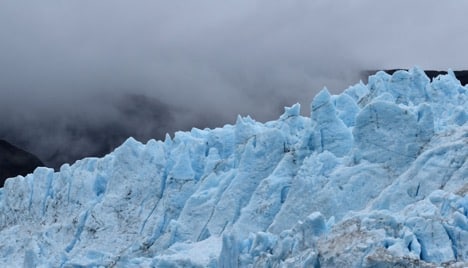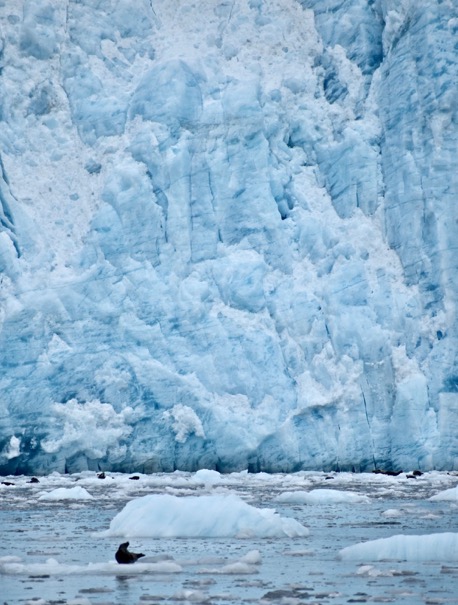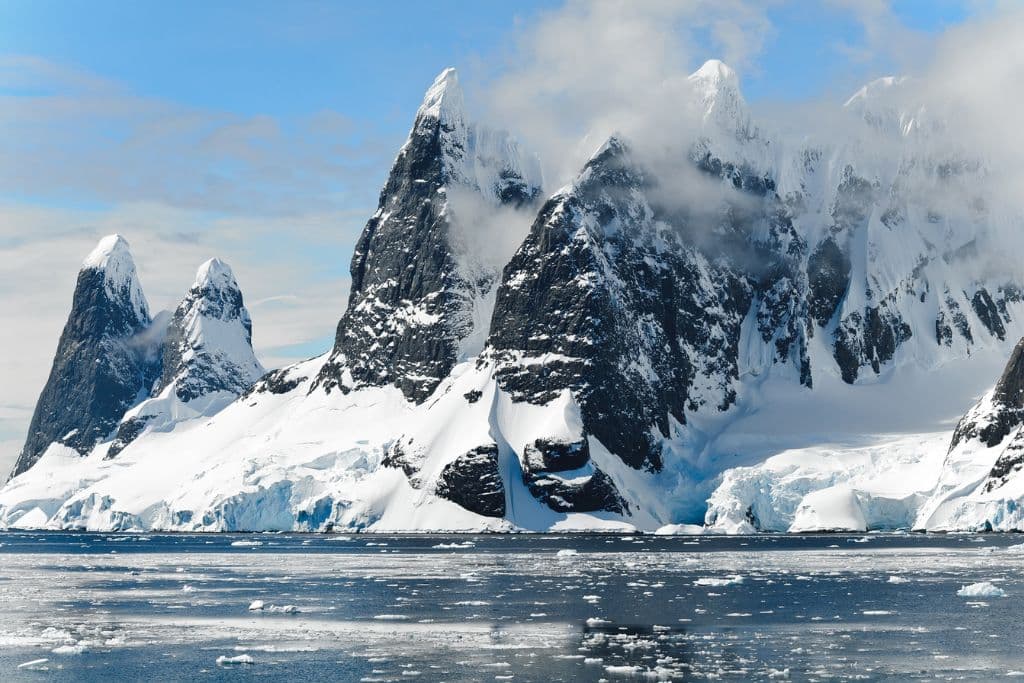Glaciers sustain life. They replenish ecosystems and provide fresh water to humans and wildlife alike. Their slow migrations leave impressive signatures on the planet, sculpting mountains and valleys as they grind across the landscape. These icy giants even offer a glimpse into our planet’s past. By studying the chemical makeup of glacial ice, scientists can better understand Earth’s earlier climates. Glaciers play an irreplaceable role in the natural world. While they have naturally cycled through periods of advance and retreat for hundreds of thousands of years, an ever-growing body of evidence shows that glacial melting is happening at an unprecedented rate due to anthropogenic climate change. As glaciers shrink in size and number, what are we at risk of losing, and what are the consequences?
—
Snow, Pressure, and Time: How Glaciers Are Born
Glaciers are huge rivers of ice that move slowly over land, driven by their own enormous weight. Similar to metamorphic rock, they are created by time and pressure. As new layers of snow accumulate each year, older layers compress until they crystallise into high-density glacial ice. This process usually takes at least a century. As more and more snow accumulates and transforms, glaciers may continue to grow for thousands of years.
Glaciers come in various shapes and sizes. Alpine glaciers, like Alaska’s famous Exit Glacier, form in mountainous regions. These flow gradually from high rock basins into valleys, leaving a moraine of rocks, sediment, and debris in their wake. Less confined by their surrounding landscape, ice sheets spread out broadly in all directions from a domed centre. Ice sheets grow to take on truly continental proportions: Earth’s two ice sheets, the Antarctic Ice Sheet and the Greenland Ice Sheet, cover a combined total of 15.7 million square miles (40.6 million square kilometres).
A Force for Good
In an exclusive interview with Earth.Org, glaciology PhD candidate Allison Chartrand (Ohio State University) weighed in on the importance of glaciers.
“[Glaciers] hold the largest freshwater reserves on the planet as a whole,” she explained. “Mountain glaciers in particular are important water resources, and they have important cultural significance for indigenous people.”
Only 2.5% of Earth’s water supply is freshwater, and over two-thirds of this small share takes the form of glacial ice. While this water may seem inaccessible compared to what flows freely in lakes and rivers, glacial melting is a vital resource for nearly 2 billion people worldwide.
Glaciers also provide for non-human organisms. Each summer, glacial melt fertilises downstream ecosystems and feeds local biodiversity. Nutrients released from the bellies of glaciers make their way to the ocean and fuel blooms of phytoplankton, a cornerstone of marine food webs. This cold water also helps regulate the temperature of alpine stream habitats, ensuring the survival of sensitive aquatic species.
Glaciers are not only important because of what they add to the environment. Thanks to the ice-albedo effect, they also help keep solar radiation out. Albedo is the measure of how much energy a surface can reflect. Due to the high albedo of snow and ice, Earth’s glaciers (particularly ice sheets) reflect a tremendous amount of solar radiation that would otherwise be absorbed by the land beneath. Sea ice, the saltwater cousin of glaciers, also plays a part in this important process by reflecting energy that would otherwise be absorbed by a darker, lower-albedo ocean. With the power to regulate how much solar energy our planet absorbs, glaciers and sea ice are critical components of Earth’s thermostat.
Going, Going, Gone
While people and plankton alike reap the benefits of seasonal glacial melting, there is a limit to how much melting is too much. This limit lies in a glacier’s mass balance, the difference between its accumulation in the winter and ablation (or shrinkage) in the summer. Under more ideal climate conditions, the mass lost after a period of melting is regained in the winter as new layers of snow transform into glacial ice. Unfortunately, these conditions do not reflect reality: recent mass balance studies show that Earth’s glaciers are melting at an unsustainable rate.
Between 2000 and 2019, glacial mass worldwide dropped roughly 267 giga tonnes per year. Researchers estimate that this melting has contributed to roughly 21% of observed sea level rise, an effect of climate change that threatens to displace millions by the end of the century. The rate at which glaciers are disappearing has risen 57% since the 1990s, and under current warming trends, two-thirds of Earth’s glaciers may vanish by 2100.
You might also like: Glacial Melting in Greenland Will Raise Sea Level by 10 Inches: Study
“A high percentage of the world’s population lives on the coast,” says Chartrand. “If sea level rises, these people are going to be displaced, and all the infrastructure we’ve built is going to be destroyed. That’s why we should care.”
Freshwater input from melting glaciers even threatens to disrupt the Atlantic Meridional Overturning Circulation (AMOC), a system of ocean currents that plays an enormous role in Earth’s climate and weather patterns. As the surface area of high-albedo glaciers and sea ice shrinks, more solar radiation is absorbed by the Earth, accelerating the cycle of warming and melting in a destructive feedback loop.
Alaska’s Exit Glacier, a major attraction in Kenai Fjords National Park, serves as a visual indicator of glacial recession due to climate change.

Alaska’s Exit Glacier, a major attraction in Kenai Fjords National Park, serves as a visual indicator of glacial recession due to climate change. Image by Logan Rance
With clear evidence that global warming is drastically impacting the cryosphere, concerned scientists are asking an important question: What happens next?
The future of Earth’s glaciers depends on whether humans can work together to limit warming. The Intergovernmental Panel on Climate Change (IPCC) predicts that a temperature rise of 1.5C beyond pre-industrial levels could trigger a series of climate tipping points. By surpassing this 1.5C threshold, there is a high likelihood of the following consequences by the end of the century:
- Half of Earth’s mountain glaciers vanish.
- The Greenland Ice Sheet reaches a tipping point of irreversible melting.
- Sea level rises roughly 48 centimetres, reshaping coastlines and displacing millions.
While limiting warming to 1.5C is an optimistic target, business as usual emissions policies will likely crank Earth’s thermostat even higher– closer to 2.7C. As the temperature climbs, the projected consequences intensify. At 3C, over 70% of Earth’s glaciers are projected to vanish. At 4C, research predicts that over one-third of Antarctica’s ice shelves will collapse.
You might also like: The Tipping Points of Climate Change: How Will Our World Change?
Thwarting the Thaw: Can Glaciers Be Saved?
Protecting glaciers requires us to prevent any additional warming we can, no matter how small it may seem.
“We’ve already passed the threshold for some glaciers being completely gone in our lifetime,” says Chartrand. “But for every bit of warming we can curb, we’ll be able to save more glaciers.”
Optimistic scientists believe that with immediate, large-scale reductions in greenhouse gas emissions and stronger emissions pledges, there is still a small possibility of limiting warming to 1.5C. Doing so would protect a larger portion of glaciers and reduce other climate-related consequences, like severe weather events and sea level rise. However, accomplishing this goal will be no small feat. As many countries continue to invest in fossil fuels and make emissions pledges they refuse to keep, the cards are stacked against glaciers and other imperilled natural resources.

Aialik Glacier in Alaska’s Kenai Peninsula. Image by Logan Rance
While our individual actions may feel insignificant, every effort is important.
“One of the most effective things we can do, something that gives me hope, is writing to congress and our lawmakers,” says Chartrand. “Writing them, or calling them, and asking ‘Hey, can you support this bill that limits emissions?’”
She also advocates using our wallets to send a message. “We can refuse to support companies that are not working to limit their emissions, and choose to support the ones that do.”

Harbor seals congregate at the base of Aialik Glacier. Image by Logan Rance.
Despite grim projections, we must not willingly accept a world void of glaciers. With their irreplaceable ecological and cultural significance, they are well worth protecting. It is essential that we collectively work to reverse our emissions and stop future warming. Earth’s glaciers, as well as the life they support, are counting on it.
You might also like: Two-Thirds of World’s Glaciers Set to Disappear by 2100 Under Current Global Warming Scenario: Study


















